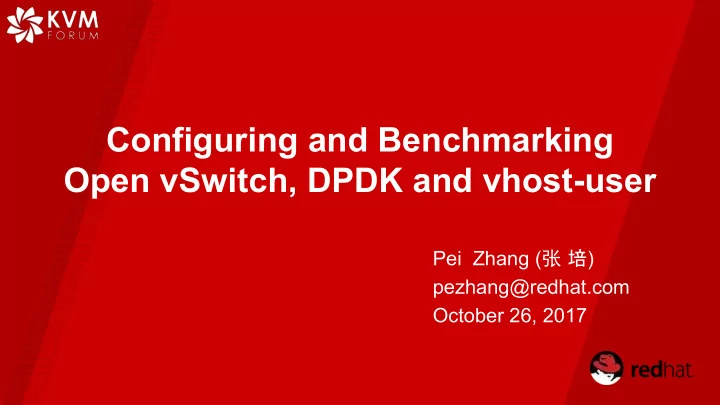

Configuring and Benchmarking Open vSwitch, DPDK and vhost-user Pei Zhang ( 张 培 ) pezhang@redhat.com October 26, 2017
Agenda 1. Background 2. Configure Open vSwitch, DPDK and vhost-user 3. Improve network performance 4. Show results
1.Background(1/2) NFV stands for N etwork F unction V irtualization, it’s a new network architecture concept. Softwares + Virtualization Replace Dedicated network appliances + Standard hardwares
1.Background(2/2) Operations/Business Support System NFV Manager & Virtual Network Functions Orchestrator NFV Infrastructure Fig. ETSI NFV Architecture Framework
1.Background(2/2) Operations/Business Support System NFV Manager & Virtual Network Functions Orchestrator NFV Infrastructure Fig. ETSI NFV Architecture Framework NFVI provides basic environment for network performance.
2.Configure Open vSwitch, DPDK and vhost-user vhost-user protocol VM Libvirt Open vSwitch DPDK kernel-rt (with DPDK-accelerated) QEMU kvm-rt/kernel-rt Red Hat Enterprise Linux 7 VFIO Hardware NIC Fig. Topology
How performance is improved? - DPDK Data Plane Development Kit(DPDK) is a set of libraries and user space drivers for fast packet processing. ➢ polling mode drivers Application using hugepage memory. ➢ running mostly in user space . ➢ DPDK user space Application kernel vfio user space kernel space System calls kernel network stack NIC kernel space Fig. packets flow with dpdk NIC Fig. standard packets flow
How performance is improved? - vhost-user vhost-user protocol allows qemu shares virtqueues with a user space process on the same host.
How performance is improved? - Open vSwitch Open vSwitch(OVS) is designed to be used as a vSwitch within virtualized server environments. vswitch vswitch user space forwarding plane (user space datapath: forwarding plane netdev) driver poll mode driver kernel space user space hardware hardware NIC NIC Fig. OVS with DPDK Fig. standard OVS
How performance is improved? - KVM-RT Real-Time always keeps low latency, it’s used for latency-sensitive workloads. Real-Time KVM(RT-KVM) is the extension of KVM, it allows the VM to be real time operating system. KVM-RT can be used in latency-sensitive VNFs.
Peculiarities summary (1) Handling network packets in user space during whole process. (2) Polling thread. (3) Hugepages. (4) Cores isolation - Isolated cores will only be used when explicitly setting. - Pin vCPUs to individual cores (5) Strict NUMA policy - Cores and memory used should be same NUMA node with network device.
How to config? - vhost-user socket <cpu mode='host-passthrough' check='none'> <feature policy='require' name='tsc-deadline'/> <numa> <cell id='0' cpus='0-3' memory='8388608' unit='KiB' memAccess='shared' /> </numa> </cpu> <interface type=' vhostuser '> <mac address='88:66:da:5f:dd:02'/> <source type='unix' path='/tmp/vhostuser0.sock' mode= 'server' /> <model type='virtio'/> <driver name='vhost'/> <address type='pci' domain='0x0000' bus='0x00' slot='0x03' function='0x0'/> </interface> # ovs-vsctl add-port ovsbr0 vhost-user0 -- set Interface vhost-user0 type= dpdkvhostuserclient options: vhost-server-path=/tmp/vhostuser0.sock
How to config? - hugepage # cat /proc/cmdline BOOT_IMAGE=/vmlinuz-... default_hugepagesz=1G # lscpu Flags: ... pdpe1g ... <memoryBacking> <hugepages> < page size='1048576' unit='KiB' nodeset='0'/> </hugepages> <locked/> </memoryBacking>
How to config? - isolate cores In normal kernel environment: In real time environment: Install package: tuned-profiles-cpu-partitioning Install package: tuned-profiles-nfv-host/guest Kernel line: # cat /proc/cmdline # cat /proc/cmdline BOOT_IMAGE=/vmlinuz-... skew_tick=1 BOOT_IMAGE=/vmlinuz-... skew_tick=1 nohz=on isolcpus=1,3,5,7,9,11,13,15,17,19,21,23,25,27,2 nohz_full=1,3,5,7,9,11,13,15,17,19,21,23,25,2 9,31,30,28,26,24,22,20,18,16 nohz=on 7,29,31,30,28,26,24,22,20,18,16 nohz_full=1,3,5,7,9,11,13,15,17,19,21,23,25,27, rcu_nocbs=1,3,5,7,9,11,13,15,17,19,21,23,25, 29,31,30,28,26,24,22,20,18,16 27,29,31,30,28,26,24,22,20,18,16 rcu_nocbs=1,3,5,7,9,11,13,15,17,19,21,23,25,2 tuned.non_isolcpus=00005555 7,29,31,30,28,26,24,22,20,18,16 intel_pstate=disable nosoftlockup intel_pstate=disable nosoftlockup
How to config? - NUMA policy # hwloc-ls Machine (64GB total) <vcpu placement='static'>4</vcpu> NUMANode L#0 (P#0 32GB) <cputune> … <vcpupin vcpu='0' cpuset='31' /> NUMANode L#1 (P#1 32GB) <vcpupin vcpu='1' cpuset='29' /> ... <vcpupin vcpu='2' cpuset='27' /> PCIBridge PCI 8086:1528 <vcpupin vcpu='3' cpuset='25' /> Net L#7 "p1p1" <emulatorpin cpuset='18,20'/> PCI 8086:1528 </cputune> Net L#8 "p1p2" <numatune> <memory mode='strict' nodeset='1' /> </numatune> Intel X540-AT2 10G Card # ovs-vsctl set Open_vSwitch . other_config: pmd-cpu-mask=0xAA (cores 1,3,5,7)
How to config? - kvm-rt <cputune> <vcpupin vcpu='0' cpuset='30'/> <vcpupin vcpu='1' cpuset='31'/> <emulatorpin cpuset='2,4,6,8,10'/> <vcpusched vcpus='0' scheduler='fifo' priority='1'/> <vcpusched vcpus='1' scheduler='fifo' priority='1'/> </cputune> - Install kernel-rt/kernel-rt-kvm - Use tuned-profiles-nfv/tuned-profiles-realtime - Set fifo:1 priority
Testing topology Note:Using individual core for each port. (6 cores in this example )
3.Improve network performance (1) Using multiple queues to improve throughput (2) Using tuned-cpu-partitioning to get 0-loss packets and lower L2 network latency (3) Using KVM-RT to get lower cyclictest latency
Higher throughput - multiple queues(1/2) Cores Number = Ports * Queues Note:Using individual core for each port each queue. (12 cores in this example)
Higher throughput - multiple queues(2/2) Open vSwitch for 2 queues: ovs-vsctl set Open_vSwitch . other_config:pmd-cpu-mask= 0xAAAA(1,3,5,7,9,11,13,15) ovs-vsctl set Interface dpdk0 options: n_rxq=2 ovs-vsctl set Interface dpdk1 options: n_rxq=2 VM for 2 queues: <interface type='vhostuser'> <mac address='88:66:da:5f:dd:02'/> <source type='unix' path='/var/run/openvswitch/vhost-user0' mode='client'/> <model type='virtio'/> <driver name='vhost' queues='2' /> <address type='pci' domain='0x0000' bus='0x00' slot='0x03' function='0x0'/> </interface>
4.Show Results (1) Multiple queues has better throughput Single queue: 13.02Mpps (43.75% of line rate 14.88Mpps) Two queues: 21.13Mpps (71% of line rate 14.88Mpps) (Better) Testing Environment: - Platform: Red Hat Enterprise Linux 7 - Traffic Generator: MoonGen - Acceptable Loss: 0.002% - Frame Size: 64Byte - Bidirectional: Yes - Validation run time: 30s - CPU: Intel(R) Xeon(R) CPU E5-2650 v3 @ 2.30GHz - NIC: 10-Gigabit X540-AT2
(2) tuned-cpu-partitioning has better 0-loss throughput and L2 network latency Throughput: - no cpu-partitioning throughput: 21.13 (0.000718% loss) cpu-partitioning throughput: 21.31(0 loss) (Better) - L2 network latency - no tuned-cpu-partitioning latency: 1242.073us cpu-partitioning latency: 37us (Better) - Testing Environment: - Platform: Red Hat Enterprise Linux 7 - Traffic Generator: MoonGen - Running time: 12 hours - Frame Size: 64Byte - Bidirectional: Yes - CPU: Intel(R) Xeon(R) CPU E5-2650 v3 @ 2.30GHz - NIC: 10-Gigabit X540-AT2
(3) kvm-rt has better cyclictest latency results non-rt: max cyclictest latency: 00616us kvm-rt: max cyclictest latency: 00018us (Better) Testing Environment: - Platform: Red Hat Enterprise Linux 7 - Testing method: cyclictest
Q&A
Thanks!
Recommend
More recommend